How to Make Pickled Cucumbers at Home – Easy, Crunchy, and Ready in Minutes
How to Make Pickled Cucumbers at Home
Pickled cucumbers are one of those timeless recipes that never go out of style. Crisp, tangy, and slightly sweet, they add a refreshing burst of flavor to sandwiches, salads, and grilled dishes. The best part? You don’t need fancy equipment or special ingredients to make them at home. With just a few cucumbers, some vinegar, sugar, and salt, you can prepare delicious homemade pickles that taste even better than store-bought ones.
This guide will walk you through every step — from selecting the right cucumbers to storing your pickles for maximum crunch. You’ll also discover the benefits of pickled cucumbers, flavor variations from around the world, and common mistakes to avoid.
What Are Pickled Cucumbers?
Pickled cucumbers, often simply called “pickles,” are cucumbers preserved in a mixture of vinegar, water, salt, and sometimes sugar. The process of pickling not only gives them their signature tangy taste but also extends their shelf life.
There are two main types of pickles:
- Quick pickles (refrigerator pickles): These are soaked in hot vinegar brine and stored in the refrigerator. They’re ready to eat within a few hours.
- Fermented pickles: These take several days or weeks to develop their flavor naturally, using saltwater and beneficial bacteria instead of vinegar.
In this recipe, we’ll focus on the quick version — simple, fast, and absolutely delicious.
Ingredients You’ll Need
To make about one medium jar of pickled cucumbers, you’ll need:
- 2 medium cucumbers
- 120 ml white vinegar or apple cider vinegar
- 250 ml hot water
- 1 tablespoon sugar
- 1½ teaspoons salt
- Optional flavorings: 1 garlic clove, a few peppercorns, or dill sprigs
These ingredients are easy to find and create a balanced flavor that’s not too sour or too sweet. You can adjust the vinegar or sugar level to match your personal taste.
Step-by-Step Recipe for Homemade Pickled Cucumbers
Prepare the cucumbers
Wash your cucumbers thoroughly to remove any dirt or residue. Slice them thinly using a sharp knife or mandoline. Thin slices absorb flavor faster, while thicker ones remain crunchier — choose according to your preference.
Make the brine
In a bowl, combine hot water, vinegar, sugar, and salt. Stir until everything dissolves. The heat helps blend the flavors and ensures a smooth, consistent brine.
Add flavor
This step gives your pickles their personality. You can add crushed garlic, black peppercorns, dill, mustard seeds, or even chili flakes. Mix and match until you find your favorite blend.
Combine and pour
Place the sliced cucumbers in a clean glass jar. Pour the warm brine over them, ensuring all slices are submerged. Use a spoon to remove air bubbles and pack them tightly.
Let them rest
Close the jar tightly and let it sit at room temperature for about 30 minutes before refrigerating. After 2–3 hours, your pickles will be ready to enjoy. For a stronger flavor, wait overnight.
Storage and Shelf Life
Keep your pickled cucumbers in a sealed glass jar in the refrigerator. They stay fresh for up to three weeks, although the flavor continues to develop over time. Avoid using metal lids, as vinegar can corrode them.
If you plan to store them longer, make sure the jar and utensils are sterilized. Cleanliness is key to preventing spoilage and maintaining that perfect crunch.
Flavor Variations from Around the World
One of the best things about pickles is their versatility. Different regions have their own twist on the recipe:
- American dill pickles: Made with dill seeds or fresh dill and garlic for a savory, herbal taste.
- Korean oi muchim: Spicy cucumber pickles flavored with chili flakes, garlic, and sesame oil — tangy and fiery.
- Japanese kyuri-zuke: Often pickled in rice vinegar with a touch of sugar and soy sauce for a mild, umami flavor.
- German gurken: Crisp pickles with mustard seeds, bay leaves, and dill, traditionally served with sausages.
- Indian cucumber pickles: Packed with turmeric, chili powder, and mustard oil — vibrant and intense.
Experiment with these global styles to discover new flavor combinations that match your dishes.
Health Benefits of Pickled Cucumbers
Besides their refreshing flavor, pickled cucumbers offer several health benefits when enjoyed in moderation.
- Rich in probiotics (in fermented versions): Natural fermentation creates beneficial bacteria that support gut health.
- Low in calories: Perfect for light snacking without guilt.
- Hydration boost: Cucumbers are over 95% water, helping maintain hydration.
- Source of antioxidants: Vinegar and cucumber skin contain compounds that help combat oxidative stress.
- Electrolyte balance: The salt content can help replenish minerals after exercise or heat exposure.
However, remember that pickles are relatively high in sodium. It’s best to enjoy them as a flavorful addition, not a main dish.
Best Ways to Serve Pickled Cucumbers
Homemade pickles are incredibly versatile. Here are some delicious ways to use them:
- As a burger topping for extra crunch
- Mixed into potato salad or coleslaw for a tangy contrast
- On sandwiches or wraps for freshness
- Chopped into tuna or egg salad for texture
- Served as a side dish with grilled meat or fish
- As a snack straight from the jar when you crave something savory
Their acidity cuts through rich or fatty dishes, making them the perfect balance to hearty meals.
Common Mistakes to Avoid
Even a simple recipe like this can go wrong if you overlook a few details. Avoid these common pitfalls for the best results:
Using old cucumbers: Always pick firm, fresh cucumbers for crunchier results. Soft ones will turn mushy after pickling.
Not dissolving salt and sugar properly: This can result in uneven flavor. Make sure the brine is fully mixed.
Skipping sterilization: If your jars aren’t clean, your pickles might spoil early.
Overheating the brine: Extremely hot liquid can cook the cucumbers, making them soft instead of crisp.
Too much vinegar: Balance is key. Too much acidity can overpower the natural cucumber flavor.
Paying attention to these details ensures perfectly crisp and flavorful pickles every time.
Tips for Perfect Crunch
- Always cool the brine slightly before pouring it over the cucumbers.
- Add a grape leaf or bay leaf to the jar; the tannins help maintain firmness.
- Store the jar at the back of the refrigerator — the temperature is more stable there.
- Use small cucumbers (gherkin type) if possible; they stay firmer after pickling.
Why Make Pickled Cucumbers at Home?
Homemade pickles are fresher, healthier, and cheaper than store-bought versions. You control every ingredient, avoiding preservatives and excessive sodium. Plus, it’s a satisfying kitchen project that requires minimal effort but delivers big rewards.
You can also experiment with different vinegars — rice, white wine, or apple cider — to discover how each one changes the taste. Once you make your first batch, you’ll likely never go back to supermarket jars again.
The Science Behind Pickling
Pickling works by creating an acidic environment that prevents harmful bacteria from growing. Vinegar (acetic acid) lowers the pH, preserving the cucumbers safely while infusing them with flavor.
The sugar balances the sharpness of the vinegar, while salt enhances taste and texture. When combined with aromatics like garlic or dill, you get a harmonious blend that develops even more depth over time.
Frequently Asked Questions
How long before they’re ready to eat?
You can enjoy them after 30 minutes, but the flavor improves significantly after 3–4 hours or overnight.
Can I reuse the brine?
Yes, once or twice within a week. Reheat it before using for another batch.
Do I need to peel the cucumbers?
No, the skin adds texture and helps them stay crunchy. Just wash them thoroughly.
Can I use different vinegars?
Absolutely. Apple cider vinegar adds fruitiness, while rice vinegar gives a gentler taste. Avoid balsamic or malt vinegar, as they overpower the flavor.
Why did my pickles turn soft?
This can happen if you used old cucumbers or poured boiling liquid directly over them. Always use firm cucumbers and slightly cooled brine.
Homemade Pickles: A Simple Joy
Making pickled cucumbers is more than just a recipe — it’s a small act of creativity in the kitchen. You transform humble cucumbers into something that can brighten every meal. The crisp bite, the tangy aroma, and the touch of sweetness create a perfect balance that delights your taste buds every time.
Once you master this simple technique, you can explore endless variations — spicy, garlicky, sweet, or even smoky. You’ll find yourself experimenting with new ingredients and sharing your creations with family and friends.
Pickled cucumbers remind us that great food doesn’t have to be complicated — sometimes, all it takes is vinegar, water, and a little patience


0 Comment